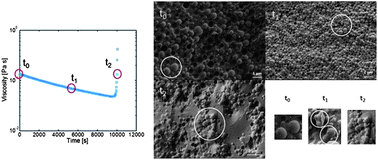Shear-stability and gelation of inverse latexes†
Abstract
Shear-induced gelation of inverse latexes (ILs) has been studied experimentally focusing on identifying the key parameters regulating shear stability. The employed IL systems consist of soft, water-swollen polymer-based particles with large particle contents, dispersed in an organic solvent and stabilized by a mixture of steric surfactants. It is found that at a fixed shear rate, the shear-viscosity of the IL systems first decreases with time (shear thinning), and then, after reaching a local minimum, it increases explosively. Cryo-SEM experiments reveal that along the shear history, the IL systems undergo competition between coalescence and aggregation, leading eventually to fractal gelation. With respect to that of non-coalescing colloidal systems, the shear-induced gelation of the IL systems results clearly from a different mechanism: coalescence slows down the gelation process by reducing the total occupied volume of the clusters. Only when the aggregation rate becomes faster than the coalescence rate, the gelation phenomenon becomes possible. Through the shear-induced gelation, we have identified the main parameters affecting the shear-stability of the IL systems, and their effects can be well interpreted by considering their role in altering the competition between coalescence and aggregation kinetics.


 Please wait while we load your content...
Please wait while we load your content...